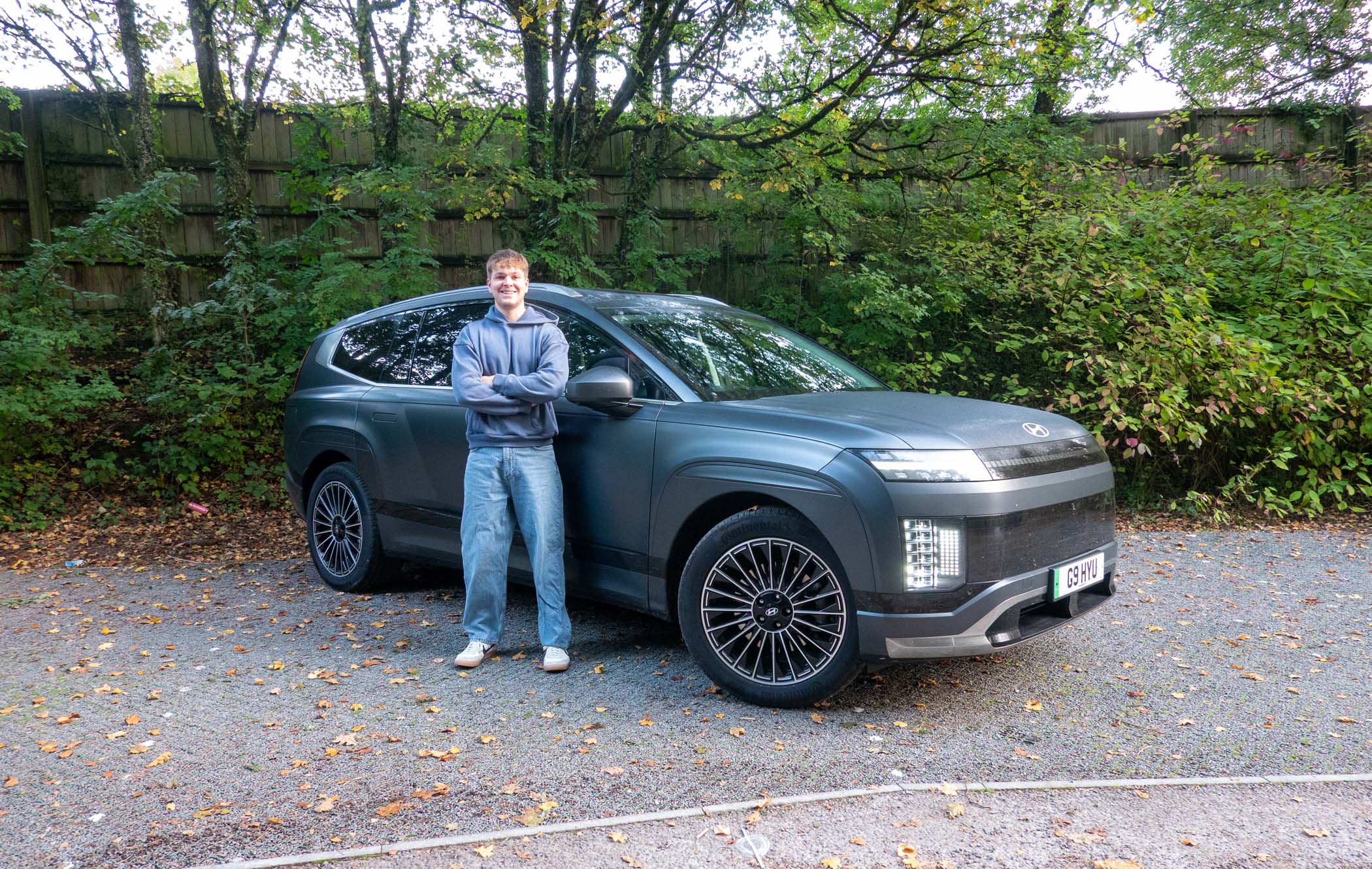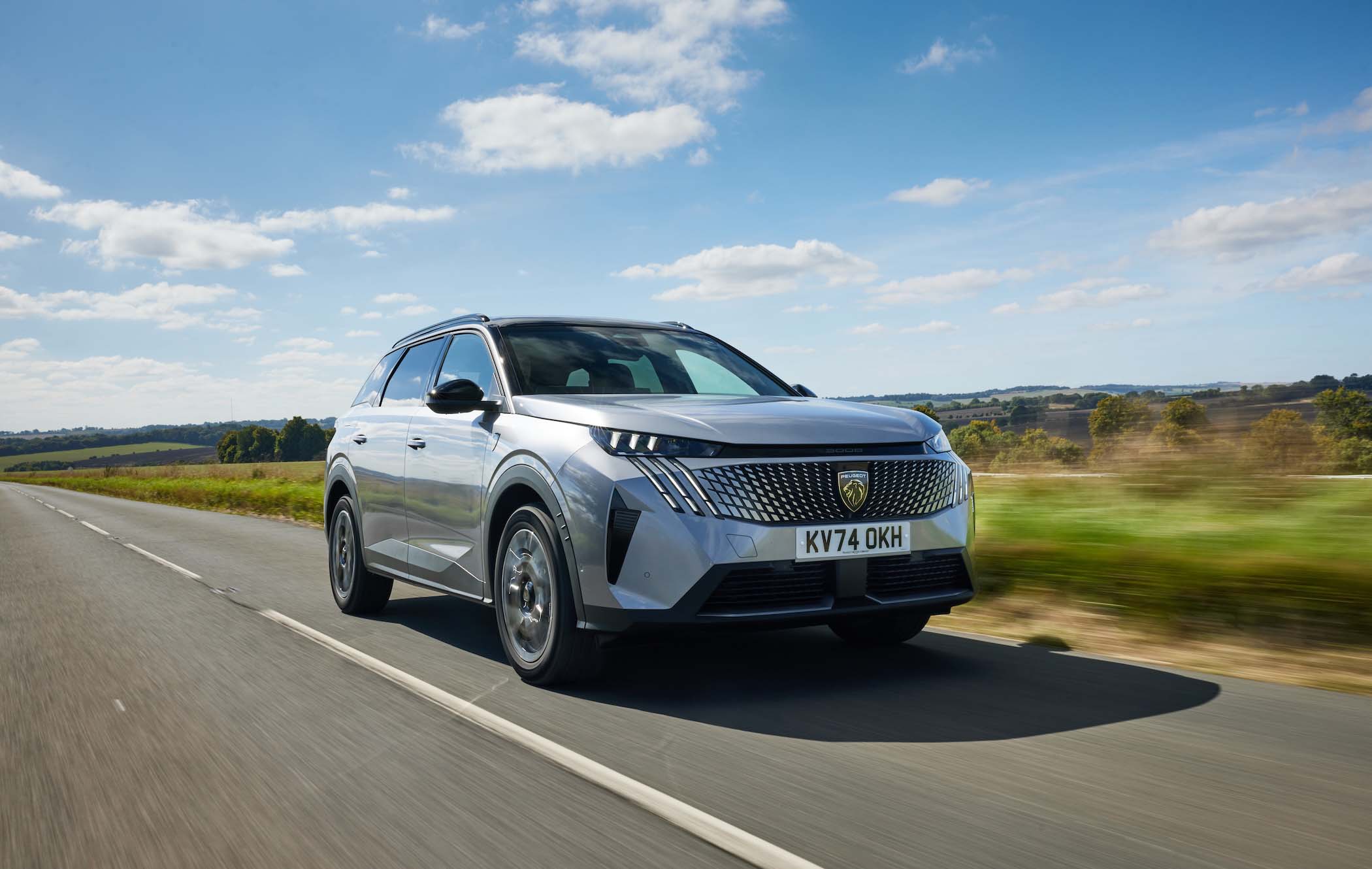Hyundai Santa Fe review
With its new, boxy looks and almost unbeatable practicality, the Hyundai Santa Fe could be considered a class-leading seven-seater SUV. But does it have the right tech, power and safety to set it apart from other cars in this space? Read our Hyundai Santa Fe review to find out.
Pros
- Impressive space across all three rows
- High specs across the board
- Quiet, comfortable ride
Cons
- Lacking in any major performance
- Big boot opening might get in the way
Interior
Our rating: 8/10
Driving position
First things first, the Hyundai Santa Fe is a tall car. Its high roofline (1,780mm) means it’s very tall , so you’d expect interior space to be plentiful.
You’ll notice this from the driver’s seat, which feels far more open and airy than many other seven-seat SUVs like the Nissan X-Trail and Peugeot 5008. Though arguably, it’s probably in a slightly bigger class of car than those because of its rear-seat usability, but more on that below.
There’s plenty of adjustability in the front seats, including electric adjustment with lumbar support on the front seats on all trims.
Go for mid-spec Ultimate and above for an electrically adjustable steering wheel.
Our top-spec test car in Calligraphy trim also had Hyundai’s ‘Relaxation Seat,’ which has a built-in leg rest and a shortcut button to extend and recline the seat to chill out at charging stops (if you go for the plug-in hybrid model) or just while waiting for your children at football.
Tech and features
Hyundai Santa Fe trims
– Premium
– Ultimate
– Calligraphy
All trim levels are packed with tech – the higher specifications only add nice-to-haves, so you can quite easily buy an entry-spec Premium model and be happy with it.
Expect twin 12.3-inch displays with wireless Apple CarPlay/Android Auto, a powered boot lid, wireless phone charging and keyless entry.
Heated front seats are also standard, but our pick would be mid-spec Ultimate if you fancy cooled front seats (and heated rear seats) too.
Unfortunately, all of this is controlled on a touchscreen panel on the dashboard – because there are so many controls on this panel, it can feel a bit awkward to use on the go. Especially as there’s no feedback when you hit the keys.
Dual-zone climate control (fitted to all Santa Fes) is at least controlled by two physical rotary dials.
Some other nice features included on higher trim levels include a digital rear-view mirror (perfect for when taller passengers in the back are blocking your view), 360-degree parking cameras and a smarter key that has controls for moving your car forward and backward.
Whether or not you’d want to be seen playing with a two-tonne remote control car in public is another thing, but it’d definitely handy when someone’s parked a little too close for you to get in.
Performance
Our rating: 6/10
Engines and power
Hyundai Santa Fe performance stats
– Power: 239hp (hybrid) or 253hp (PHEV)
– 0-62mph: 9.0-9.3 seconds
– Top speed: 112 mph
– Driven wheels: Front-wheel drive or four-wheel drive
Power comes from a 1.6-litre turbocharged petrol engine, either in self-charging hybrid (215hp) or plug-in hybrid (253hp) form.
Despite their healthy power outputs, the 1,900-2,145kg kerb weight means the Santa Fe is a pretty heavy car, so neither engine option feels particularly quick.
In fact, they it takes 9.3-9.8 seconds to reach 62mph, which is fairly slow by today’s standards, but this is a heavy car.
We tested the 4x4 version of the self-charging hybrid, which is the slowest of the bunch (not that there’s much in it). We felt it lacked a sense of urgency or oomph, particularly on the motorway, but around town the electric boost keeps it feeling nippy enough.
Because they’re paired with six-speed automatic gearboxes and there’s not a huge amount of power on offer (compared to the weight), we often felt that the car was revving highly in a lower gear to pick up pace.
Maybe a beefier electric motor, or a bigger petrol engine, would negate some of these issues. But for the school run or nipping about town, the PHEV is a joy. Even on a longer motorway trip – once you’re at speed – it’s comfortable and refined.
Handling and ride comfort
At least the Santa Fe has comfort on its side thanks to specially designed suspension to reduce vibrations from the road.
All models also come with self-levelling rear suspension to keep the car flat, regardless of load.
Our road testing on the bigger 20-inch alloys was a positive affair, with only the biggest potholes throwing it off beat.
One of the trade-offs for having any large SUV is that it’ll never quite be as agile as, say, a hot hatch. But families don’t want that.
We found the Santa Fe to be perfectly adept to tight and twisting country lanes, but the Peugeot 5008 does feel a little more car-like (at the cost of rear-seat space).
Practicality
Our rating: 9/10
Boot space
Hyundai Santa Fe boot space
– Boot space: 985 litres
– Inc. Rear seats folded: 1,949 litres
If boot space is what you need, you can fold the third row down for 985 litres of space, which is more than the Peugeot 5008 (916 litres), Škoda Kodiaq (845 litres) and even the huge, electric Hyundai IONIQ 9 (908 litres).
With the two rear rows down, space is still impressive, at 1,949 litres.
When you’ve got three rows of seats up, the boot space shrinks to the point that you’ll only be able to fit soft bags in, much like its counterparts. Hyundai doesn’t actually quote a size, here.
However, if boot space and passenger room are both important to you, the IONIQ 9 offers far more space in the back.
It’s worth noting that the shape of the rear end, including the low position of the number plate, means the boot door itself is pretty big. This might make access to the boot awkward if you’re backed into a tight space, but it does double as an excellent rain canopy .
Rear seats
Maybe this is where the Hyundai Santa Fe plays its trump card, because it’s one of the few seven-seaters that you’d genuinely be happy travelling in any row. It’s far more practical than even luxury cars like the Volvo XC90 or Audi Q7.
Our test car was the six-seat configuration, which places two captain-style armchairs in the middle row, each with a built-in armrest. You could climb through the middle to reach the back, if you wanted.
The seven-seat model has a more conventional bench, but you can still slide and recline.
There’s no denying the back seats are the smallest of the three rows, but you could still sit an adult there in relative comfort.
Getting in and out is also easy – if you don’t want to clamber through the middle, they’ll tilt and slide forward to reveal a pretty wide opening.
Top marks, then, for the Hyundai Santa Fe, which is up there with the most usable seven-seaters on the market.
Storage solutions
Drivers on the internet have been pretty vocal about the number of cupholders in the Santa Fe – we counted two in the centre console, two in each rear door and two for each of the third-row passengers (so that’s 10).
Every door bin also has a cutout for a small or medium bottle, so make it 14.
We think the best feature, though, is the storage space under the front armrest. It’s hinged from both the front and the back, so front-row and middle-row passengers can all get access.
It’s also extremely deep (enough to stand a laptop upright), and the bottom portion underneath the false floor can be accessed via a sliding drawer from the middle row.
This is an excellent example of interior packaging done right.
The list goes on, though, because besides a conventional glovebox, there’s also a secondary, smaller glovebox-style cubby above it, and a shelf in between the two to pop your phone on.
The flush grab handles next to the rear windows are also a neat feature for climbing up onto the tyre when you’re fitting things to the roof like a roof box – very Land Rover Defender-esque.
Hyundai Santa Fe dimensions:
– Height: 1,780mm
– Width: 1,900mm
– Length: 4,830mm
– Gross weight: 1,900-2,095kg
Safety
Look at Hyundai’s spec sheet and you’ll see that all cars have at least: Blind Spot Collision Avoidance Assist, Forward Collision Avoidance Assist 1.5, Lane Follow Assist 2, Highway Drive Assist and more.
This is Hyundai-speak for active driver aids to keep you centred in your lane, and at a safe distance from the car in front.
We love that you can tweak the lane-keep assist and adaptive cruise control separately via buttons on the steering wheel, so you can choose to have one or the other – or both systems working in tandem.
In 2024, Euro NCAP awarded the Santa Fe four out of five stars. Additional safety kit gives it the full five-star rating, increasing pedestrian protection and adding more safety assist systems, but it’s important to note that adult and child protection levels are the same.
Running costs
Our rating: 7/10
Fuel economy
The Santa Fe held onto its diesel engine for many years, but when this fifth generation landed with its bold, boxy looks, it dropped diesel altogether.
If you’re going into hybrid ownership for the first time, you might be expecting higher fuel economy figures, but it’s better to think of the self-charging hybrid as more of a diesel replacement than a true eco-warrior.
In our testing, we averaged around 37-41mpg, with the higher figures surprisingly coming from motorway driving, and local driving reducing performance.
Hyundai claims around 33 miles of electric-only range from the plug-in hybrid, and we’ve no reason to doubt this. Its electric motors tend to be highly efficient.
Electric power comes from a 13.8kWh battery, which is small by plug-in SUV standards today, but it’ll still be enough to cover most local trips with zero tailpipe emissions.
Reliability
Hyundai has built itself a solid reputation for reliability, and the Santa Fe lives up to that.
The 1.6-litre hybrid is also highly tried-and-tested, stemming from the earlier IONIQ before going into most of Hyundai’s mid-size and larger cars since (albeit in various forms).
The five-year/unlimited-mileage warranty is one of the best in the business – some manufacturers give you more years, but most have a mileage cap.
The verdict
Interior
8/10
Performance
6/10
Practicality
9/10
Running costs
7/10
On the whole, the Hyundai Santa Fe nails nearly everything a large family SUV should be – there’s enough space in all three rows, a premium-feeling cabin and an unimaginable quantity of cupholders.
Dive a little deeper and it’s easy to feel somewhat underwhelmed by its power options, but then you remember this is a two-tonne seven-seater that’s built around family life and you can let it off.
Hybrid running costs might be better in Hyundai’s other models, but the Santa Fe should still be cheaper to run than its diesel predecessors, and about on par with other similarly-sized models.
Then there’s the fact that the entry-level model is called Premium, and it feels just that. All versions of the Santa Fe feel suitably luxurious, but you’ll never feel like you’ve overspent.
If you’re in the market for a large, adult-friendly seven-seater, it’s hard to recommend anything else, but if you are open to spending more on an electric alternative, then the Hyundai IONIQ 9 does offer more boot space and cheaper running costs.


